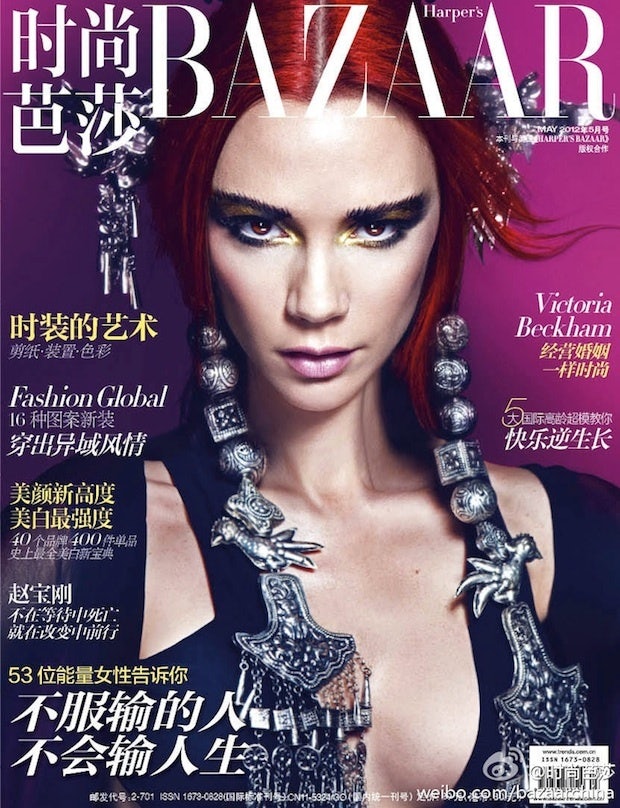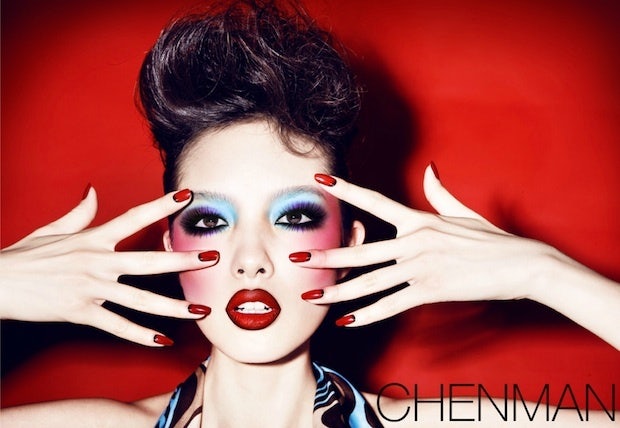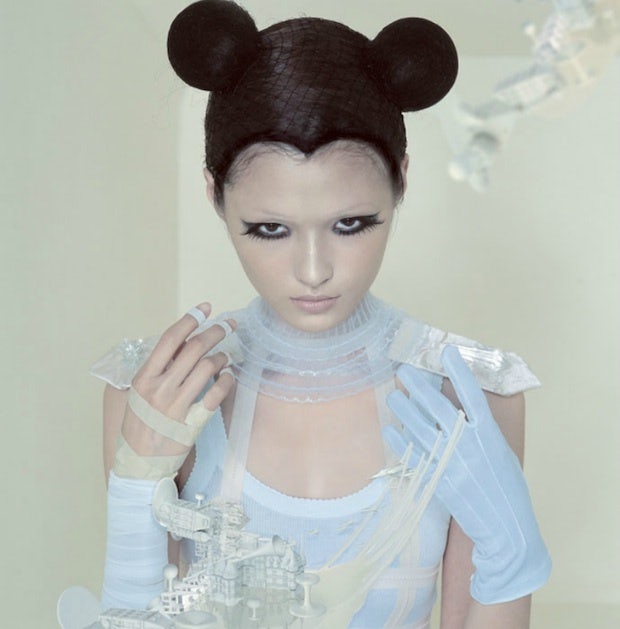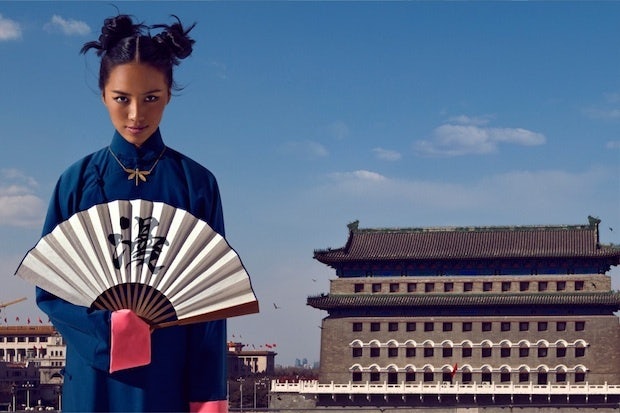"It’s Time For The New Generation To Build Its Own Aesthetic & Moral Language"#
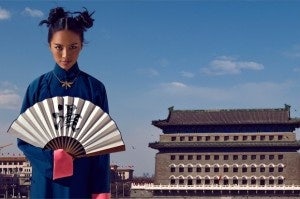
Since bursting onto the scene in 2003, Beijing native
Chen Man#
(陈曼) has emerged as China's leading fashion photographer. Having launched her career with Chinese Vision magazine, Central Academy of Fine Arts-trained Chen -- known for her stylized, highly saturated and somewhat surreal imagery and otherworldly sense of color -- has become one of her country's most sought-after fashion photographers. In recent years, Chen has made a name for herself shooting celebrities like Victoria Beckham, Faye Wong, Fan Bingbing and Domenico Dolce and Stefano Gabbana for the Chinese editions of magazines such as ELLE, Vogue and BAZAAR, as well as campaigns for brands like Shanghai Tang, Absolut, Celine, Shiseido and Coach. This year, Chen's work has appeared on the cover of i-D magazine's Chinese New Year issue, and Chen's collaboration on a makeup collection with the New York-based cosmetic brand M.A.C. was released worldwide this March. Like contemporaries such as Quentin Shih (Jing Daily interview), Chen's work fits in a unique and nebulous niche, somewhere between fine art and commercial fare, giving it a global appeal to art-lovers and brands alike and, as such, keeping her extremely busy.
Recently, Jing Daily discussed Chen's conceptions of China's emerging photography scene, how she sees her place in it, and what she thinks of comparisons to her work with that of Lady Gaga. Interview translated from the original Chinese.
Jing Daily (JD): How do you conceptualize fashion and art in China today, and its relationship to the post-80s and post-90s generations?
#
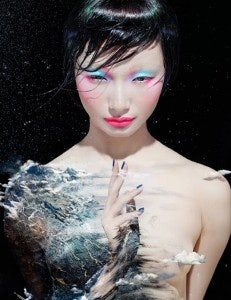
Chen Man (CM)#
: For the young generation raised in the 1990s, they enjoyed the material world as imported from Western countries, and they got jobs, got married, settled down, and had a baby relatively easily. Although people outside of China think Chinese society is dynamic right now, actually it's pretty restrained. Since Chinese people don't like local brands, local designers can't get the respect they often deserve. This is also why China doesn't have any important independent local designer brands as of yet. Chinese society is sort of innately feudal, and the country comparatively recently went through the Cultural Revolution. Therefore, Chinese people are used to suppressing their inner thoughts, pretending they're satisfied with their circumstances, and Chinese society embraces the values of the Western material world.
The new generation should stop imitating Western, Japanese and Korean culture, heritage from "old China," political pop, the played-out symbols of the Cultural Revolution, and so forth. It's about time for the new generation to build their own aesthetic and moral language.
JD: Do you see your work as fitting in this current state, or existing somewhat outside of it?
#
CM#
: My work can be categorized into three phases, and I was trying to define myself [as a photographer] during the first two phases. In my first phase, which I call my “Vision” phase, I was still in college. At that time, I did a lot of post-processing with my work. I wanted to explore my creativity -- I was young and enthusiastic about exploring creativity, always trying to add new elements to my work. It was an exceptionally exciting and creative period in my career.
When I entered the world of fashion, many people were concerned about my "style" of excessive post-processing. People were worried I'd make my models look like ghosts or demons. At that point, I transitioned from a phase of overly processed images into a sort of minimalistic stage, composing photos without any post-processing. This transition made me realize I was good at more than just post-processing. Also at that point, I gained more celebrity clients, which paved the way to becoming a mainstream fashion photographer today.
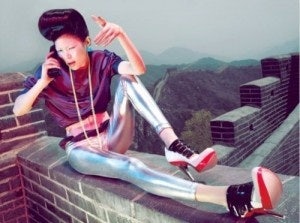
Having worked with many celebrity clients, I gradually became more interested in incorporating more elements of contemporary China into my work. I wanted to create a whole series based on where the country's at right now. This series actually has a very special meaning to me. I was really the first mainstream fashion photographer to portray contemporary China and the faces of contemporary Chinese. China's always been a follower of Western and Japanese/Korean trends, and the reason nobody really tried to use contemporary China as a backdrop for their work is because it can look "old fashioned" if it's not done right. I felt I could do it because I'm a truly local photographer who never studied abroad. Also, I'm really familiar with the visual industry here, and maybe most importantly, I really believe this is something I should do.
China shouldn't always dwell on its long history. I want to capture contemporary China, Chinese conceptions of beauty, and to show the world today's China as it really is. The most iconic set in this series is my photos of Lü Yan on the Great Wall. It was a project for a mainstream fashion magazine, and also was my first time shooting on the Great Wall. That particular set caused a stir when it was released. "The Mirror" in Hong Kong wrote about it and said it was a revolutionary milestone in Chinese fashion.
My third and current phase is more spiritual compared to the other two. I'm combining my knowledge of ancient Chinese philosophy with Western ideals, highlighting the importance of maintaining inner and outer balance from a materialistic perception of human existence, taking a visual approach.
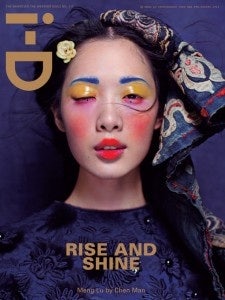
JD: One journalist recently wrote that, "Like Lady Gaga and her team, [Chen Man] is skilled at blending beauty with ugliness." How do you feel the roles of beauty and ugliness inform your work?
#
CM#
: There are two kinds of beauty – natural beauty and inner beauty. I believe the combination of natural beauty and inner beauty is what human should strive for, otherwise we may as well go back to being tribal. What people perceive and believe to be “environmentally friendly” determines the fate of our world. Our world has become driven by materialism, and therefore it's ever more important to promote the ideological conception of “Harmony” – using minimal resources and maximum intelligence to create a better world. This is what our world needs. My goal is to present this ideological concept of “Harmony” with visuals in my work to make it more understandable for people.
JD: Your work alternates from personal artwork to commercial projects. Do you think your commercial photography work influences your art? If so, how?
#
CM#
: I believe my personal artwork and commercial projects are in a balanced relationship. Almost all artists nowadays like to cross over between their personal and commercial work. Commercial products can be art as well, such as the iPad. We should refrain from classifying and putting a set label on everything.
JD: How you do walk the line between making art that is personally satisfying to you as a photographer, and work for brands and magazines that makes clients happy?
#
CM#
: Figuring out how to strike a balance is kind of like a science -- it takes talent and knowledge, luck and wisdom.
JD: Can you tell us a little about your recent collaboration with M.A.C. cosmetics? How did that partnership come together, and how did you feel about the results?
#
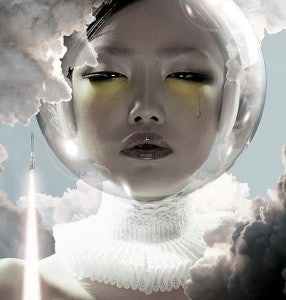
CM#
: The first phase of my work attracted them. Phillip [Ing, vice-president of global retail and special events for M.A.C.] was sort of like my talent scout. He approached me a while back and we started the project two years ago, and we then had a wonderful start to our relationship.
Actually, two years is a very long time, and for the project it was basically like a super-long childbirth process. During that process, I also gave birth to my own child. The creativity and color you see in the collection now were actually there two years ago. The "Love and Water" series I did for M.A.C. is my interpretation of what I said earlier about the environmental concept of the integration between human beings and the natural world. Love represents consciousness and invisibility, while water represents substance and visibility. The combination of the two is life.
JD: Do you plan to work on additional partnerships with brands?
#
CM#
: I'm always working on new plans and projects. Most recently, I've been working on a new cooperation with M.A.C.
JD: What projects are you working on right now?
#
CM#
: At the moment, I've got to keep that a secret.
JD: Who are some of your favorite photographers right now, whether in China or elsewhere?
#
CM#
: Lately, [British photographer] Michael Jackson and China's Liu Xiangcheng (刘香成).
